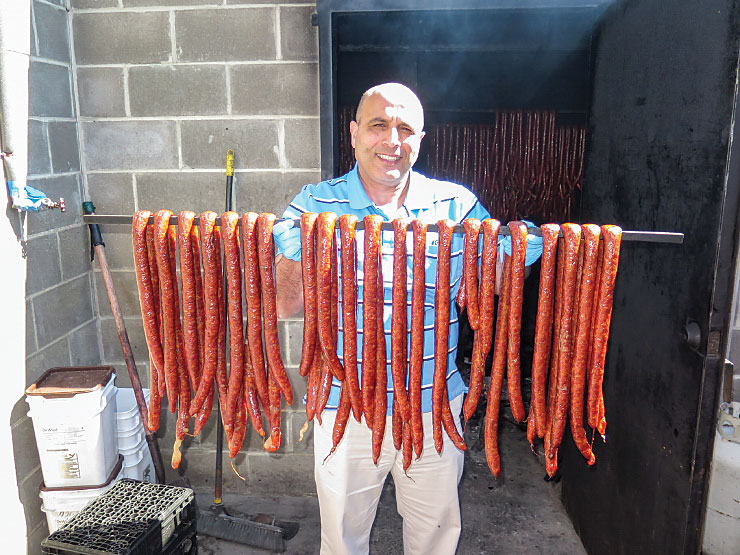Louisiana’s Cajun country is a complex blend of traditions, cultures and food all wrapped up in a region with one-of-a-kind wetlands and a laid-back lifestyle
My wife, Monika, placed our purchases on the counter at a Podunk grocery store where we’d stopped for supplies. The older woman who worked there had a sparkle in her eyes and wrinkles that showed the hard life of surviving several hurricanes. She said to Monika with some sincerity, “Honey, what’s y’all gonna cook for anyone with one onion?!” There’s a saying in southwest Louisiana that if it walks, crawls, swims, flies or slithers, you’ll find it at the bottom of a well-seasoned cast-iron pan.
Southwest Louisiana is Cajun country, and Cajun country is about food, music and dance, but there was also more to learn. We started at Adventure Point, the fabulous satellite office of the Lake Charles Convention and Visitors Bureau, in the town of Sulphur, taking exit 20 off Interstate 10. Other visitor centers in Lake Charles proper and at the Cameron Prairie National Wildlife Refuge are equally informative. All of them have great hands-on displays for children and adults with inquisitive minds — plus Wi-Fi.
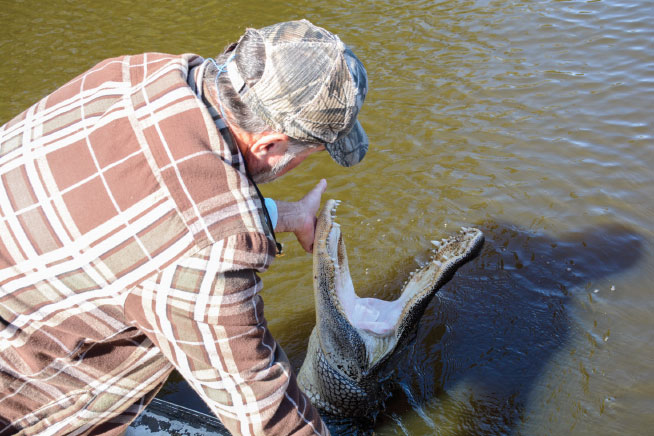
Airboat tour guide Captain Tucker Friedman has a friendly relationship with a few of the local alligators.
Creole Nature Trail
Looking at a map of this corner of the country, you’ll see that a lot of it is under water, bisected by the Intra-coastal Waterway and numerous rivers, lakes and bayous. For those not from these parts, a bayou is a slow-moving creek or a swampy section of a river or a lake. As a slice of the Pleistocene Prairie Terrace, southwest Louisiana is some of the youngest land on the North American continent.
The best way to get a feeling for this unique region is to follow the 180-mile Creole Nature Trail All-American Road. The drive passes through several nature preserves and wildlife refuges, with stops at wildlife viewing sites. It runs all the way to the beaches of the Gulf of Mexico where you may find dozens of shell varieties on the sand at low tide, especially after a storm.
Birds can be seen year-round, but March and April may be the best months to spot the more than 400 species that migrate through the nature preserves. While birds are beautiful, alligators can be more exciting. We did use caution as we walked the nature trails, knowing that alligators can have a running speed of 20 to 25 mph — if they spot something that looks like part of the food chain. Keep your dog on a short leash.
For a safer, more personal encounter with these toothy beasts, we stopped at Atchafalaya Basin Landing and Marina for an up-close look at the ancient cypress trees, impressive bodies of water and, of course, the alligators. As it turned out, our swamp-tour guide at the helm of the airboat had a personal relationship with a few of the gators.
Shrimp, on the other hand, required no net or boat. We were able to find them fresh by the pound at several roadside shops. One shrimper and his wife were happy to show us the quick way to shell them.
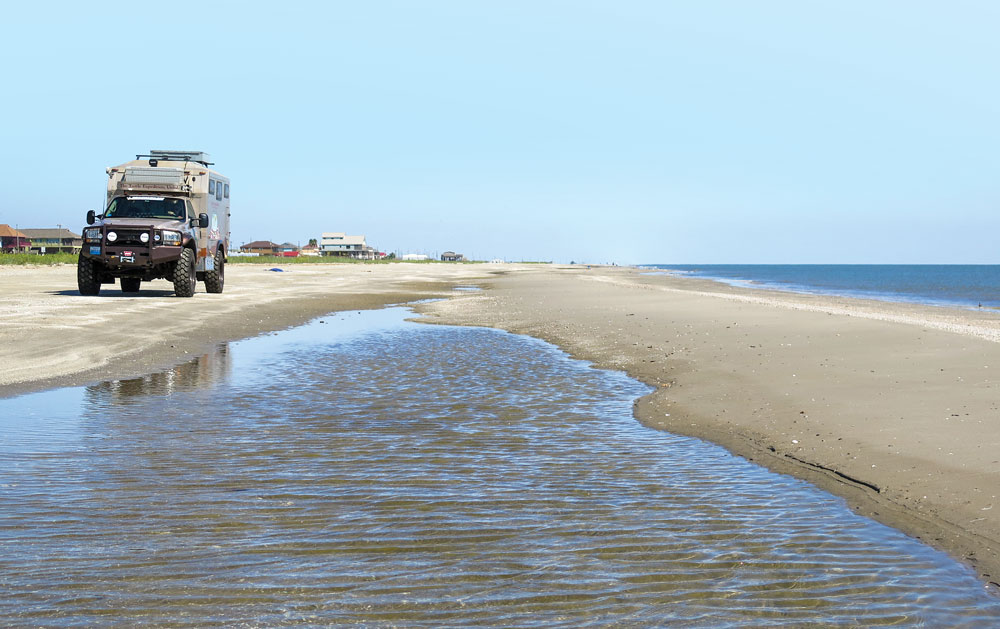
The long beaches of the gulf coast offer many miles of shoreline and numerous varieties of shells after a high tide.
Toe-Tapping Zydeco
An equally important aspect of Cajun country is the music, especially the unique, fast-tempo zydeco. The music arose as a synthesis of traditional Creole music, Cajun influences and African-American traditions, including R&B, blues, jazz and gospel.
A typical band is composed of a sax player, an electric guitarist or bassist, and most importantly, an accordion player and someone stroking an old metal washboard or maybe clacking some spoons. It’s music you can listen to, but, as we discovered, its primary purpose is for dancing. When the band strikes up a favorite tune, you can’t keep your foot from tapping. The music integrates waltz, shuffle, two-step, blues and rock ’n’ roll — so the excuse “I can’t dance” doesn’t really fly.
By chance, just up the road from Atchafalaya Basin Landing, we discovered the Whiskey River, a dancehall well known by the locals for its Cajun and zydeco bands. Horace Trahan and the Ossun Express were playing. I was taking pictures, and when I turned around, Monika was already out on the floor with a partner. Hey, that got me off the hook!
Avery Island
Almost everyone has heard of and maybe tasted the spicy pepper sauce called Tabasco. We were surprised to learn that it is still produced on Avery Island in southwest Louisiana and has been since 1868 when Edmund McIlhenny invented it. One of five wooded “islands,” Avery sits atop a deposit of solid rock salt that geologists believe is a remnant of buried ancient seabed. Indigenous plants and wildlife occupy the roughly 2,200-acre island, which is surrounded by low-lying swamps and marshes.
A tour of the Tabasco factory gave us some fascinating history about the hot stuff we’ve been adding to our Bloody Marys for years. The original seeds of the peppers (Capsicum frutescens) came from Mexico or Central America. Today, Tabasco is labeled in 22 languages and dialects, and sold in more than 180 countries and territories.
The special peppers are handpicked using le petit bâton rouge, or “the little red stick,” as a guide. Painted the color of a ripe Tabasco pepper, the stick ensures only the ripest red peppers are picked. After the peppers are mashed, they are aged in white-oak barrels for up to three years. A member of the McIlhenny family personally inspects each barrel of pepper mash and deems the aging process complete.
Just across the road from the Tabasco factory is the real treasure of the island, Jungle Gardens and its Bird City. Covered with a layer of fertile soil, Jungle Gardens is one of the world’s most beautiful nature sanctuaries and is open every day of the year.
White snowy egrets swooped across the calm water of Bayou Petite Anse. Alligators and turtles basked in the sun, watching us with their curious squints. We wandered and drove through the 200 acres of flowers and evergreens. Massive live oaks were draped dramatically with Spanish moss, filtering morning light across our path.
Again, thanks to McIlhenny, or “Mr. Ned,” as he was affectionately known, his Bird City is home to thousands of migrating egrets and herons. They were once near extinction when plume hunters slaughtered them by the thousands for feathers to make fashionable ladies’ hats. In the Chinese Gardens, a temple and Buddha statue date back hundreds of years.
Jefferson Island
Island hopping, so to speak, was a short drive over to Jefferson Island and the semitropical Rip Van Winkle Gardens. We found safe overnight parking and were ready to explore the area at first morning light. Sitting atop another prehistoric salt dome next to Lake Peigneur, the 20-acre Rip Van Winkle Gardens was named after Joseph Jefferson, the acclaimed American actor who played the role of Rip Van Winkle from the Washington Irving tale for many years in the theater. His magnificent Southern mansion was built in 1870 in the Moorish style and is richly appointed in period furnishings and paintings. Tours started at 9 a.m., and we were in line.
The 20 acres surrounding the Joseph Jefferson estate are seasonally home to 12 species of exotic birds that draw photographers from around the world. Roseate spoonbills are a favorite, and peacocks wander the grounds and roost in the live oaks at night. All told, more than 400 species can be spotted as they come in from two major flyways. The Café Jefferson was open for lunch, and we enjoyed ours with a lovely view of the gardens and lake.
Sugar, Rice and Cajun Spice
Driving some of the side roads that crisscross this part of the state, we couldn’t help but notice the thousands of acres of sugarcane being harvested. Our curiosity prompted us to stop at the St. Mary Sugar Co-op processing plant. They don’t offer official tours, but Micah Guidry, safety and personnel director, was kind enough to show us around.
Louisiana is the second largest producer of cane sugar in the United States with 13 million tons of cane harvested yearly. The St. Mary Sugar Co-op alone refines 1.2 million tons of cane into 134,000 tons of raw sugar. The yearlong choreographed process that gets that little spoon of sugar to your coffee cup is amazing. If you need to feel better about it, the truth is that sugar is pure, contains no man-made chemicals or warning labels, is 100 percent natural and contains less than 16 calories per teaspoon.
The history of southwest Louisiana is part of its allure. In the footsteps of the native Coushatta people, a melting pot of arrivals made their mark on this unique culture, starting in the 16th century when Spanish Conquistadors landed on the Mexican coast. They were followed by Spanish and French Creole immigrants, Anglo-Celtic settlers, slaves that worked the sugar and cotton plantations, Tennessee and Kentucky solders who served in the 1815 Battle of New Orleans and French-speaking Acadians (Cajuns) exiled from Canada — and that’s just for starters. Museums in towns throughout the region add depth to the story.
We weren’t in time for the annual Fat Tuesday celebration, but the Mardi Gras Museum of Imperial Calcasieu in Lake Charles has the largest display of Mardi Gras costumes in the South. In New Iberia we found the oldest rice mill in the United States. Listed on the National Register of Historic Places, the mill is still using machinery from 1912. The W.H. Tupper General Merchandise Store in Jennings opened in 1910 and now is a museum with more than 10,000 items on display, many in the original packaging and still bearing the original price tags.
While we were in Jeanerette, we had to stop at LeJeune’s Bakery, opened in 1884, for one of its famous loaves of French bread and a few ginger cakes, hot out of the oven. The Jeanerette Bicentennial Park and Museum is a jewel full of antiques where we watched a fabulous video on planting, harvesting and processing sugarcane. It was also a good place for a picnic.
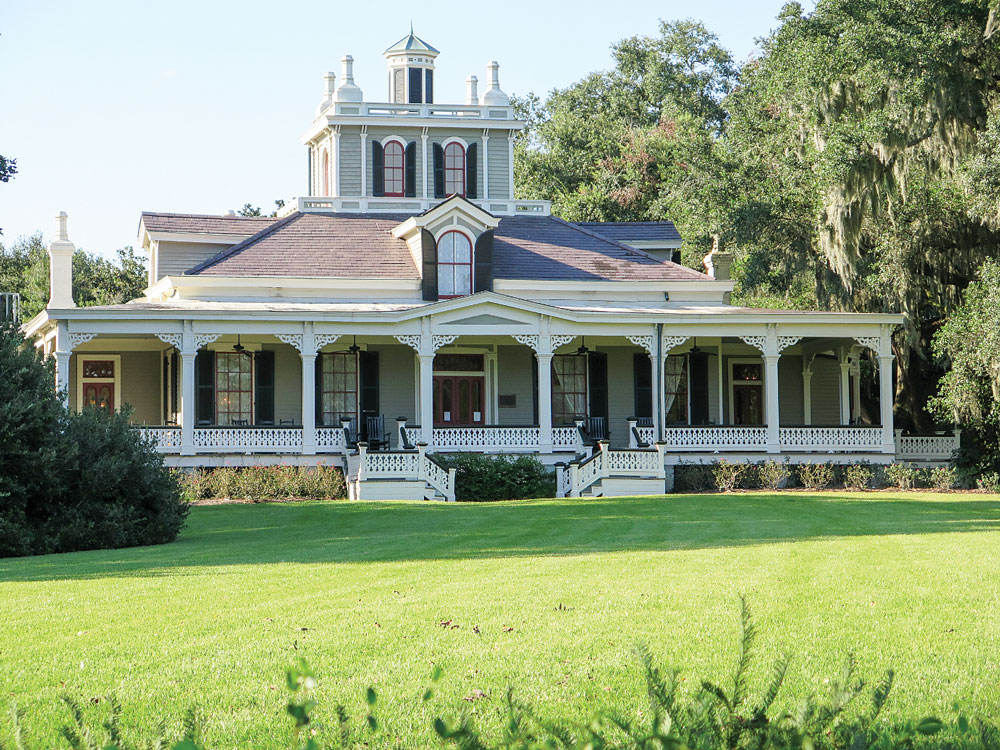
Located in Rip Van Winkle Gardens on Jefferson Island, the 22-room Joseph Jefferson Mansion was built in 1870 and is decorated in period furnishings, paintings and heirlooms.
Circling back toward Lake Charles, we pulled into the huge parking lot next to Bord du Lac Park, right on the lake, for a quick overnight stay. A stroll along the boardwalk took us to watch fishermen in the evening, and a fantastic children’s playground next to the parking area made us wish we were a few decades younger. In Sulphur, we found the A+ Motel and RV Park to be one of the best-managed and cleanest parks we’ve seen anywhere in the country.
Back on the food trail again, we had been hearing about boudin since crossing the border into Louisiana. Napa Valley has wine. Chicago has pizza. Wisconsin has cheese. And southwest Louisiana has boudin. It’s a staple of this region and is the one delicacy most widely consumed. Of course, we had to try it, and everyone had their opinion of where to get the best. That choice was made more difficult by the fact that there are at least eight main versions including black, white, pork, crawfish, alligator and shrimp. Basically, boudin is a mixture of cooked meat, rice and spices carefully blended and stuffed into natural pork casing.
Following our diligent research, we found what was clearly the best boudin and its accompaniment, smoked spicy sausages, at a little hole-in-the-wall store and butcher shop called Homsi’s on Broad Street in Lake Charles (another location is on Kirkman Street). Sam Homsi gave us a tour of his kitchen and smokehouse, and we walked out with a hot sausage in our hands. After trying his boudin that has won awards year after year, we liked it enough to bring home several pounds. Boudin and smoked sausage are already cooked, so they travel well and require only reheating.
Our minds kept coming back to food — sort of. You may recall that a good part of southwest Louisiana is covered with lakes, rivers and bayous, not to mention its proximity to the Gulf of Mexico, and that means some of the finest fishing anywhere. We had not brought our gear, but there are numerous fishing outfitters in the area, and we saw plenty of evidence of their daily success during our stay at the A+ Motel and RV Park. Redfish are a popular catch, but flounder, amberjack, spotted bass, speckled trout and even one of the best fighting and eating fish, the mahi-mahi or dorado, can be landed.
Next time we are here, we will be sure to bring our tackle and a well-seasoned cast-iron frying pan. Oh, and a few more onions, in case y’all stop by our camp.
Southwest Louisiana Essentials
 BELL CITY
BELL CITY
Cameron Prairie National Wildlife Refuge
Twenty-five miles southeast of Lake Charles, the visitor center for the entire Southwest Louisiana National Wildlife Refuge Complex offers an orientation video, wildlife exhibits and an outdoor bird-viewing platform.
337-598-2216 | www.fws.gov/refuge/cameron_prairie
BREAUX BRIDGE
Atchafalaya Basin Landing and Marina
The area’s largest fleet of airboats transports guests on guided swamp tours into the heart of the Atchafalaya Basin. Located at 1377 Henderson Levee Road, the marina runs daily tours, weather permitting.
337-228-7880 | www.basinlanding.com
LAKE CHARLES
Lake Charles Convention and Visitors Bureau
On the south side of I-10 at 1205 N. Lakeshore Drive, the regional visitor center is staffed with helpful assistants and stocked with tourism brochures and maps. The center welcomes travelers with free coffee, Wi-Fi and restrooms — and its own alligator pond.
337-436-9588 | www.visitlakecharles.org
SULPHUR
Creole Nature Trail Adventure Point
Hands-on displays introduce visitors to the natural wonders and unique culture of southwest Louisiana. Just south of I-10 from Exit 20, Adventure Point is open daily
at 2740 Ruth Street.
337-502-4358 | www.visitlakecharles.org/creole-nature-trail
Where to Stay in Cajun Country
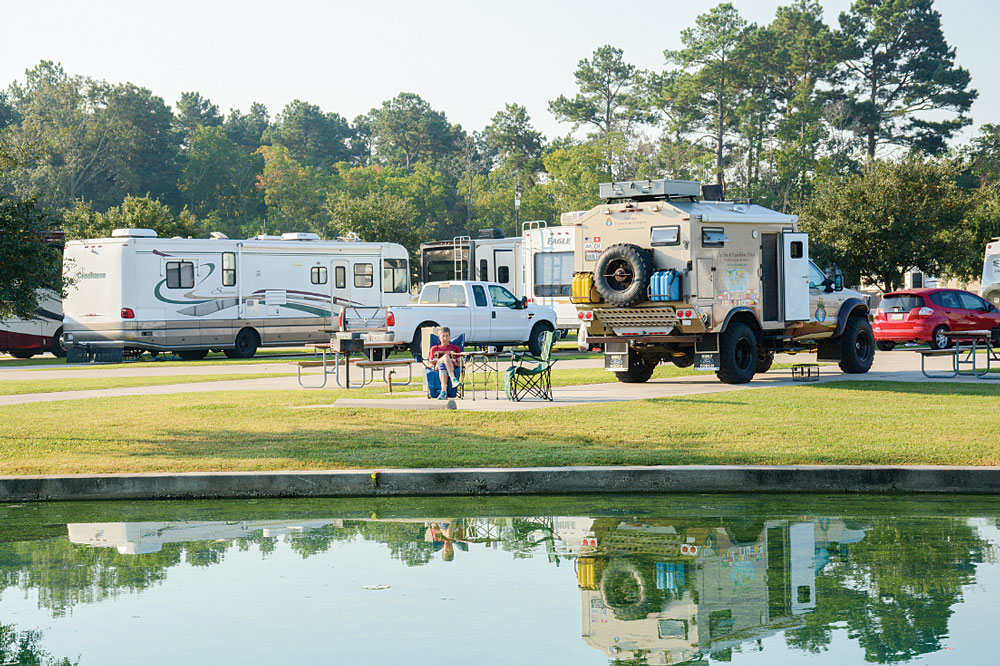
The loaded-with-amenities A+ Motel and RV Park in Sulphur makes an ideal base camp from which to explore southwest Louisiana.
SULPHUR
A+ Motel and RV Park
337-583-2631, www.a-plusmotel.com
Hidden Ponds RV Park
800-440-4709, www.hiddenpondsrvpark.com

